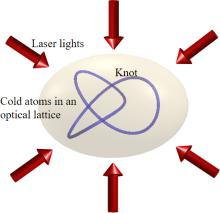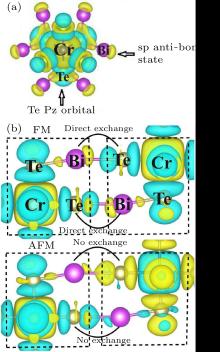|
|
Ab Initio Studies of Radicals HB$X$ ($X$=H, F, Cl, Br): Molecular Structure, Vibrational Frequencies and Potential Energy
Qi-Xin Liu, Min Liang, Quan Miao, Jin-Juan Zhang, Er-Ping Sun, Ting-Qi Ren
Chin. Phys. Lett. 2018, 35 (1):
013101
.
DOI: 10.1088/0256-307X/35/1/013101
We describe high-level ab initio calculations on the BH$_{2}$, HBF, HBCl and HBBr radicals. Molecular structure, vibrational frequencies and potential energy curves of the ground state and the first excited state, which are two Renner–Teller components for a $^2{\it \Pi}$ state at linearity, are studied using the basis sets aug-cc-pVTZ and icMRCI+Q technique. On the basis of the potential energy curves, a reliable potential energy barrier to dissociation HB+$X$ ($X$=F, Cl, Br) fragments and to linearity are given. The ab initio results will add some understanding on the spectrum and the photo-dissociation dynamics of the series of radicals.
|
|
|
Width-Dependent Optical Properties for Zigzag-Edge Silicene Nanoribbons
Hai-Rui Bao, Wen-Hu Liao, Xin-Cheng Zhang, Min Zuo
Chin. Phys. Lett. 2018, 35 (1):
013301
.
DOI: 10.1088/0256-307X/35/1/013301
We study theoretically the optical response for perfect zigzag-edge silicene nanoribbons with $N$ silicon atoms of the A and B sublattices ($N$-ZSiNRs) under the irradiation of an external electromagnetic field at low temperatures. The 8- and 16-ZSiNRs are demonstrated to exhibit a broad energy regime of absorption coefficient, refractive index, extinction coefficient, and reflectivity from infrared to ultraviolet, utilizing the dipole-transition theorem for semiconductors. The optical spectra for 8- and 16-ZSiNRs may be classified into two types of the transitions, one between valence and conduction subbands with the same parity, and the other among the edge state and bulk state subbands. With the increase of the ribbon width, the optical spectra for ZSiNRs are proved to exhibit red shift and blue shift at the lower and higher energy regimes, respectively. The obtained novel features are believed to be of significance in designs of silicene-based optoelectronic devices.
|
|
|
Probe Knots and Hopf Insulators with Ultracold Atoms
Dong-Ling Deng, Sheng-Tao Wang, Kai Sun, L.-M. Duan
Chin. Phys. Lett. 2018, 35 (1):
013701
.
DOI: 10.1088/0256-307X/35/1/013701
Knots and links are fascinating and intricate topological objects. Their influence spans from DNA and molecular chemistry to vortices in superfluid helium, defects in liquid crystals and cosmic strings in the early universe. Here we find that knotted structures also exist in a peculiar class of three-dimensional topological insulators—the Hopf insulators. In particular, we demonstrate that the momentum-space spin textures of Hopf insulators are twisted in a nontrivial way, which implies the presence of various knot and link structures. We further illustrate that the knots and nontrivial spin textures can be probed via standard time-of-flight images in cold atoms as preimage contours of spin orientations in stereographic coordinates. The extracted Hopf invariants, knots, and links are validated to be robust to typical experimental imperfections. Our work establishes the existence of knotted structures in Hopf insulators, which may have potential applications in spintronics and quantum information processing.

|
|
|
Surface Carbonization of GaN and the Related Structure Evolution during the Annealing Process
Jin-Long Liu, Liang-Xian Chen, Jun-Jun Wei, Li-Fu Hei, Xu Zhang, Cheng-Ming Li
Chin. Phys. Lett. 2018, 35 (1):
016101
.
DOI: 10.1088/0256-307X/35/1/016101
To explain the stabilization mechanism of the carbon-ion-implanted GaN under the diamond growth environment, the luminescence characteristics and structure evolution correlative with sites' carbon atoms located for high-fluence carbon-ion-implanted GaN are discussed. GaN is implanted with carbon ion using fluence of $2\times10^{17}$ cm$^{-2 }$ and energy of 45 keV. Then the implanted samples are annealed at 800$^{\circ}\!$C for 20 min and 1 h under the N$_{2}$ atmosphere. The luminescence characteristics of carbon-ion-implanted GaN are evaluated by photoluminescence spectrum at wavelength 325 nm. The lattice damage of GaN is characterized by Raman spectrum and the corresponding vacancy-defect evolution before and after annealing is measured by slow positron annihilation. The results show that most of the carbon atoms will be located at the interstitial sites after carbon ion implantation due to the weak mobility. As the implanted samples are annealed, strong yellow luminescence is emitted and the vacancies for Ga (V$_{\rm Ga})$ are reduced resulting from the migration of interstitial carbon (C$_{\rm i})$ and formation of complexes (C$_{\rm Ga}$ and/or C$_{\rm Ga}$-C$_{\rm i}$) between them. As the annealing time is prolonged, the carbon ions accommodated by the vacancies are saturated, vacancy clusters with carbon atoms appear and the concentration of C$_{\rm Ga}$ diminishes, which will have an adverse effect on the diamond film nucleation and growth.
|
|
|
Electronic Structure and Visible-Light Absorption of Transition Metals (TM=Cr, Mn, Fe, Co) and Zn-Codoped SrTiO$_{3}$: a First-Principles Study
Yue-Qin Wang, Yin Liu, Ming-Xu Zhang, Fan-Fei Min
Chin. Phys. Lett. 2018, 35 (1):
017101
.
DOI: 10.1088/0256-307X/35/1/017101
First-principles calculations are performed on the influence of transition metal (TM=Cr, Mn, Fe, Co) as codopants on the electronic structure and visible-light absorption of Zn-doped SrTiO$_{3}$. The calculated results show that (Zn,Mn)-codoped SrTiO$_{3}$ requires the smallest formation energy in four codoping systems. The structures of the codoped systems display obvious lattice distortion, inducing a phase transition from cubic to rhombohedral after codoping. Some impurity Cr, Mn and Co 3$d$ states appear below the bottom of conduction band and some Fe 3$d$ states are located above the top of valence band, which leads to a significant narrowing of band gap after transition metal codoping. The enhancement of visible-light absorption are observed in transition metals (TM=Cr, Mn, Fe, Co) and Zn codoped SrTiO$_{3}$ systems. The prediction calculations suggested that the (Zn,Mn)- and (Zn,Co)-codoped SrTiO$_{3}$ could be the desirable visible-light photocatalysts.
|
|
|
Temperature Evolution of Energy Gap and Band Structure in the Superconducting and Pseudogap States of Bi$_2$Sr$_2$CaCu$_2$O$_{8+\delta}$ Superconductor Revealed by Laser-Based Angle-Resolved Photoemission Spectroscopy
Xuan Sun, Wen-Tao Zhang, Lin Zhao, Guo-Dong Liu, Gen-Da Gu, Qin-Jun Peng, Zhi-Min Wang, Shen-Jin Zhang, Feng Yang, Chuang-Tian Chen, Zu-Yan Xu, Xing-Jiang Zhou
Chin. Phys. Lett. 2018, 35 (1):
017401
.
DOI: 10.1088/0256-307X/35/1/017401
We carry out detailed momentum-dependent and temperature-dependent measurements on Bi$_2$Sr$_2$CaCu$_2$O$_{8+\delta}$ (Bi2212) superconductor in the superconducting and pseudogap states by super-high resolution laser-based angle-resolved photoemission spectroscopy. The precise determination of the superconducting gap for the nearly optimally doped Bi2212 ($T_{\rm c}=91$ K) at low temperature indicates that the momentum-dependence of the superconducting gap deviates from the standard $d$-wave form ($\cos(2{\it \Phi}$)). It can be alternatively fitted by including a high-order term ($\cos(6{\it \Phi}$)) in which the next nearest-neighbor interaction is considered. We find that the band structure near the antinodal region smoothly evolves across the pseudogap temperature without a signature of band reorganization which is distinct from that found in Bi$_2$Sr$_2$CuO$_{6+\delta}$ superconductors. This indicates that the band reorganization across the pseudogap temperature is not a universal behavior in cuprate superconductors. These results provide new insights in understanding the nature of the superconducting gap and pseudogap in high-temperature cuprate superconductors.
|
|
|
Stepping Stone Mechanism: Carrier-Free Long-Range Magnetism Mediated by Magnetized Cation States in Quintuple Layer
Chunkai Chan, Xiaodong Zhang, Yiou Zhang, Kinfai Tse, Bei Deng, Jingzhao Zhang, Junyi Zhu
Chin. Phys. Lett. 2018, 35 (1):
017502
.
DOI: 10.1088/0256-307X/35/1/017502
The long-range magnetism observed in group-V tellurides quintuple layers is the only working example of carrier-free dilute magnetic semiconductors (DMS), whereas the physical mechanism is unclear, except the speculation on the band topology enhanced van Vleck paramagnetism. Based on DFT calculations, we find a stable long-range ferromagnetic order in a single quintuple layer of Cr-doped Bi$_2$Te$_3$ or Sb$_2$Te$_3$, with the dopant separation more than 9 Å. This configuration is the global energy minimum among all configurations. Different from the conventional super exchange theory, the magnetism is facilitated by the lone pair derived anti-bonding states near the cations. Such anti-bonding states work as stepping stones merged in the electron sea and conduct magnetism. Further, spin orbit coupling induced band inversion is found to be insignificant in the magnetism. Therefore, our findings directly dismiss the common misbelief that band topology is the only factor that enhances the magnetism. We further demonstrate that removal of the lone pair derived states destroys the long-range magnetism. This novel mechanism sheds light on the fundamental understanding of long-range magnetism and may lead to discoveries of new classes of DMS.

|
|
|
Deformation and Spallation of Explosive Welded Steels under Gas Gun Shock Loading
Ying Yu, Chao Li, Hong-Hao Ma, Mei-Lan Qi, Sheng-Nian Luo
Chin. Phys. Lett. 2018, 35 (1):
018101
.
DOI: 10.1088/0256-307X/35/1/018101
We investigate deformation and spallation of explosive welded bi-steel plates under gas gun shock loading. Free surface histories are measured to obtain the Hugoniot elastic limit and spall strengths at different impact velocities. Pre- and post-shock microstructures are characterized with optical metallography, scanning electron microscopy, and electron backscatter diffraction. In addition, the Vickers hardness test is conducted. Explosive welding can result in a wavy steel/steel interface, an ultrafine grain region centered at the interface, and a neighboring high deformation region, accompanied by a hardness with the highest value at the interface. Additional shock compression induces a further increase in hardness, and shock-induced deformation occurs in the form of twinning and dislocation slip and depends on the local substructure. Spall damage nucleates and propagates along the ultrafine grain region, due to the initial cracks or weak interface bonding. Spall strengths of bimetal plates can be higher than its constituents. Plate impact offers a promising method for improving explosive welding.
|
24 articles
|